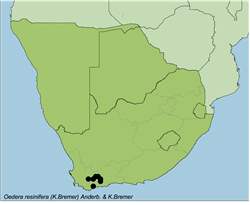Names and synonyms
Oedera resinifera (Bremer) Anderberg & Bremer
= Relhania resinifera Bremer
Type
Bremer 216, Little Karoo, Wittepoort, stony ridge, 750 m, 1972 (S).
Common names
Taaiperdekaroo
Derivation of names
Oedera = after George Christian Oeder (1728-1791), professor of Botany in Copenhagen, author of Flora Danica
resinifera = bearing resin, resinous
Diagnostic characters
Pappus of scales
Capitula long and narrow
Capitula in terminal clusters, on pedicels longer than the length of the capitulum
Involucral bracts acute, without membranous margins
Lamina of ray florets short, about a third the length of the involucre.
Description
A moderately branched shrub, up to 1 m high. Stems ascending-erect, glabrous or sparsely tomentose, leafy, becoming glabrous and nude and marked with leaf-scars. Leaves alternate, in five indistinct, slightly twisted rows, erecto-patent, � flat, narrowly elliptic, 6-10 x 1.5-3 mm, glabrous or pilose marginally and on midrib dorsally, indistinctly glandular-punctate, very glutinous, acute. Capitula 3-7(-11) together in terminal cymes, heads are about 10 mm in diameter and carried on long peduncles, 2-25 mm long, a character that is distinctive for this species. Peduncles 25 mm long. Involucre narrowly cup-shaped, 2.5-5 mm wide. Involucral bracts 25-35, in five slightly twisted vertical rows, innermost up to x 2 mm, acute. Receptacle convex, paleate. Paleae canaliculate, linear or narrowly lanceolate, 6-8 x 0.5-1 mm, dorsally gland-dotted, acute. Ray florets 5-10, lamina elliptic, 3-5 x 1-1.5 mm, 4-veined. Disc florets 15-30, perfect, tube densely glandular on upper half. Cypselas terete or somewhat angular, narrowly oblong, 2.2-3.5 x 0.4-0.6 mm wide, glabrous or sparsely pilose basally and on lateral ribs; slightly more hairy in ray florets. Pappus crownlike, of � connate scales, up to 1 mm long.
Flowering time
Mainly from August to October.
Distribution
This is a drought-resistant species growing on stony and rocky ground in the Little Karoo. Endemic to the western Klein Karoo.
Known from about 7 specimens.
Habitat
Abundant in clayey soils.
Notes
This little known rare species is a rather tall shrub with slender capitula. It is very glutinous with leaves as sticky as those of O. viscosa. However, O. resinifera is more closely allied to O. multipunctata, from which it differs in its elliptic, very glutinous leaves and characters of the cypselas.
References
ANDERBERG, A.A. & BREMER, K. 1991. Parsimony analysis and cladistic reclassification of the Relhania generic group (Asteraceae - Gnaphalieae). Annals of the Missouri Botanical Garden 78: 1061-1072.
BREMER, K. 1976. The genus Relhania (Compositae). Opera Botanica 40.
GLEN, H.F. 2004. SAPPI, What's in a Name? The Meanings of the Botanical Names of Trees. Jacana.
GOLDBLATT, P. & MANNING, J.C. 2000. Cape Plants. A conspectus of the Cape flora of South Africa. Strelitzia 9. SANBI.
KESTING, D. & CLARKE, H. 2008. Botanical names, what they mean. Wild Flowers of the Cape Peninsula, 3rd revised edition. Friends of Silvermine.
VLOK, J. & SCHUTTE-VLOK, A L. 2010. Plants of the Klein Karoo. Umdaus Press
